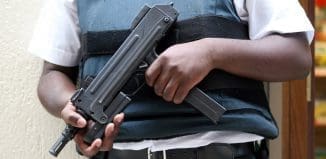Detecting concealed weapons from a distance – the challenge
This post is also available in:  עברית (Hebrew)
עברית (Hebrew)
 New technologies that will help detecting concealed weapons on people in a very fast way are being developed in Israel.
New technologies that will help detecting concealed weapons on people in a very fast way are being developed in Israel.
In the meantime the New York City Police Department (NYPD) has a new tool which detects concealed firearms – even underneath layers of clothing – by the way they block naturally occurring terahertz radiation from the human body.
The “T-Ray” can be mounted on a tripod or vehicle and deployed in locations with high incidences of gun violence. Eventually, they hope it will be small enough to wear on a belt.
To develop the device, the NYPD worked together with the London Metropolitan Police and Digital Barriers, the T-Ray’s manufacturer, using US Defense Department funding. The device is seen by privacy advocates as a way to maintain public safety without having to resort to the controversial “stop and frisk” practice. Others, however, express concern over whether it might identify “false positives” as weapons when they really aren’t. The NYPD is working with lawyers to figure out how best to deploy the T-Ray within Constitutional protections.
The company has previously release details about another member of its remote concealed weapon detection system the ThruVision TS5 .
The company claims that it’s the world’s leading safe and non-invasive increased distance people screening system, providing effective detection of larger objects at standoff distances up to 20m and smaller items at distances up to 10m. The compact unit is IP65 rated for continued operation in harsh outdoor environments and it is available in a range of colours to suit military and commercial applications. The TS5 is available with a range of accessories to support both permanent installation and mobile deployments.
At the heart of the TS5 is the ThruVision TeraHertz passive screening technology that provides effective detection of concealed objects at standoff distances. It operates by receiving natural energy radiated from the people and objects being imaged and, as such, it is non-invasive and safe. ThruVision is available in a range of form factors, from rapidly deployable mobile units to fixed units for compliant screening in controlled settings.






























